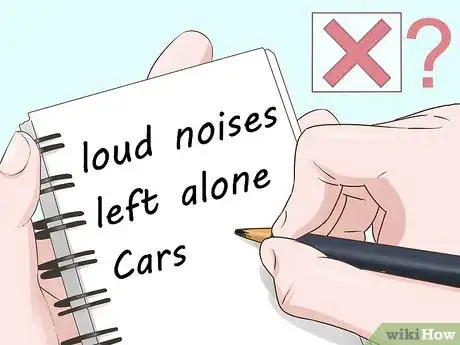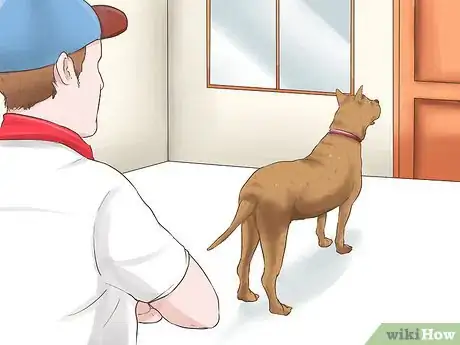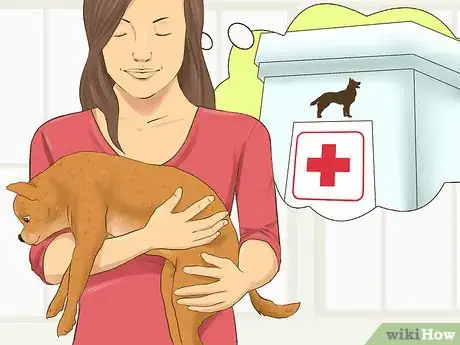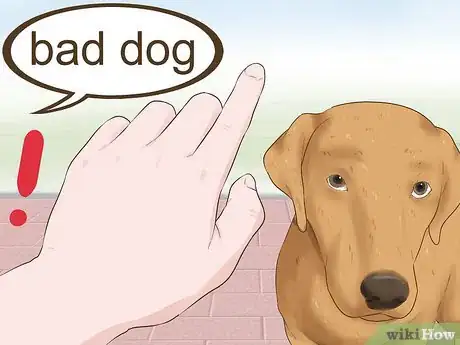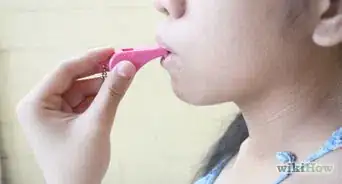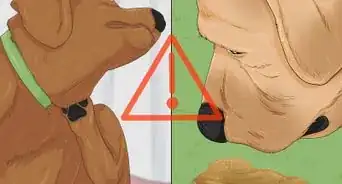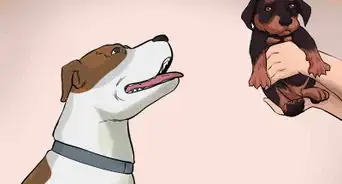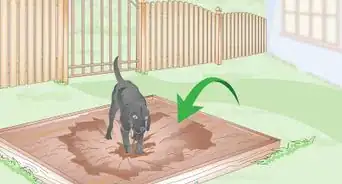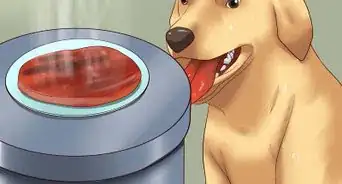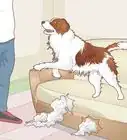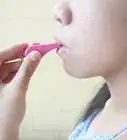This article was co-authored by Ovidiu Stoica. Ovidiu Stoica is a Professional Dog Trainer and the Founder/Owner of NYC Doggies. With over 20 years of professional experience working with dogs, Ovidiu is well versed in providing various dog care services and specializes in dog obedience and behavioral training. Ovidiu and his staff, who have more than 45 years of cumulative experience in the NYC dog walking business, provide personalized dog services including dog training, walking, hiking, boarding, sitting, and puppy care.
This article has been viewed 14,684 times.
Having a dog that behaves badly can be very stressful. Not only is your dog wrecking your house or harassing strangers, but you also might feel like your dog’s behavior is your fault or that your dog doesn’t like you. Thankfully, you can change your dog’s behavior through identifying triggers, desensitizing your dog to stressful stimuli, and reinforcing good behaviors.
Steps
Identifying the Bad Behavior
-
1Make a list of everything that triggers bad behavior. Chances are that your dog isn’t bad all around. Rather, your dog responds badly to certain stimuli. Before you can correct your dog’s bad behavior, you need to know what triggers it.[1]
- Pay attention when your dog behaves badly. Ask yourself what was happening right before the bad behavior.
- Observe your dog closely at all times for about a week. You might be surprised to find out what small things trigger bad behavior.
- Common triggers for dogs are other dogs, people, other animals, cars, loud noises, and being left alone.
-
2Take note of how your dog reacts to triggers. If you’re going to retrain your dog’s bad behavior, you need to know exactly what behaviors you want to change. Note how your dog responds to triggers.[2]
- You’ll probably recognize the response right away since you’ve seen it before. If your dog barks when someone knocks on the door, notice if your dog shrinks into a corner in fear or lifts up its ears in excitement.
- If your dog tears up furniture when you’re away, pay attention to what kinds of furniture your dog goes for.
- Note whether your dog reacts differently to similar kinds of triggers. For example, note if your dog pees on the floor when there’s a knock on the door, but whimpers when there’s a thunderstorm.
Advertisement -
3Take your dog to a vet. Bad behavior can be the result of an underlying health issue that is making your dog uncomfortable. Sometimes treating the health issue will cure the bad behavior.
- Ask the vet to do a full check-up.
- If no health issues are found, ask the vet for their advice on how to deal with your dog’s bad behavior.
Retraining Your Dog
-
1Avoid rewarding bad behavior. For a dog, most attention is seen as a reward. Thus, if you give your dog lots of attention after it has acted badly, you’re reinforcing the behavior.[3]
- If your dog jumps up on you, then either back away or stand up while also refusing to give your dog any eye contact.
- If you come home and find your dog has dug up the backyard, calmly approach your dog and place it in time-out in a kennel.
- Don’t yell at your dog when it’s bad. This will only provide reinforcement for the behavior.
-
2Use clear, simple words like “no,” “bad dog,” and “good dog.” You need to communicate to your dog that it’s engaged in bad behavior and then redirect it to a good behavior and reward it for that behavior. After your dog does something bad, say “no” and then ask your dog to do something positive like sit. If your dog performs the good behavior, say “good dog” and give your dog attention.[4]
- If your dog jumps on the furniture, say “no, down.”
- You can also train your dog to jump onto the floor and use this command when he gets up on the furniture. To do this, keep a pouch of your dog’s favorite treats on hand. Each time your dog gets up on the furniture, throw a treat on the floor and as you do this say “floor.” Teaching your dog “up” in the same way to get them to jump up onto the furniture on cue may also reduce their desire to jump up on the furniture.
- As a last resort if training does not help, approach your dog without looking him in the eye and pull him off the couch. Calmly place your dog in a time-out without saying another word. This will tell the dog that he will not get attention by jumping on the furniture.
- Always follow negative reinforcement with positive reinforcement. After you let your dog out of a time-out in its kennel, tell it to lie down and pat its belly when it complies. This will tell the dog that it will get attention when it follows commands.
-
3Desensitize your dog to stressful stimuli. Most stressful stimuli cannot be avoided altogether, so it’s important to train your dog to stay calm after being triggered. The best way to do this is by slowly introducing your dog to the stimulus. Begin by making sure you’re in a controlled environment like your house. Otherwise, other factors can influence your dog’s behavior.[5]
- Start with a very low-level stimulus. For example, if your dog is scared of thunder, play a quiet recording of thunder on your stereo.
- If your dog stays calm with the low-level stimulus, reward it with attention. If not, reduce the stimulus and start over.
- Slowly increase the level of the stimulus and reward your dog each time it stays calm.
-
4Stick to a regular training schedule. If you want to change your dog’s behavior, you need to be consistent with your approach. Otherwise, your dog won’t learn which behaviors you really consider good and bad.
- You can’t take time off from retraining your dog. You need to consistently discipline your dog when it misbehaves and follow up the discipline with positive reinforcement of good behaviors.
- Make sure everyone in your household is on board. Tell everyone about the plan to retrain your dog and explain that you want them to follow your lead.
- If you’ll be out of town for a few days, get someone you trust to care for your dog while you’re gone. Explain that you’re retraining your dog and how the caretaker should respond to your dog’s behavior.
Preventing Bad Behavior
-
1Minimize stressful stimuli. Not all stresses can be avoided, but you can manage your dog’s environment to avoid the worst triggers. Doing so will cut down on the amount of retraining you need to do.[6]
- If your dog tears up the house when you’re away, consider why this might be. Is your dog anxious because of your absence? If so, then crate training may be a good way to reduce their anxiety and protect your belongings when you are gone. Even better, hire a dog sitter or a dog walker.
- If your dog is afraid of strangers, keep it in another room when strangers come by your house and speak with a behaviorist about working on your dog’s fears.
- If your dog is afraid of thunderstorms, turn on music during a storm and close the shades.
-
2Keep your dog entertained. Dogs often engage in undesirable behaviors because they’re bored. If you keep your dog entertained with fun activities and lots of exercise you will see a large drop-off in bad behavior.[7] [8]
- Walk your dog every day. Dogs need exercise. If you can’t walk your dog because you’re at work, hire someone to walk your dog.
- Take your dog to the park to play with other dogs. Dogs need to socialize with other dogs every now and then.
- Let your dog play outside if you have a fenced-in yard.
- Provide your dog with toys and activities. If your dog doesn’t have anything to play with, it will find something on its own—and that will usually be your stuff.
-
3Reward good behavior. Your dog wants your attention. If you give it positive attention when it's a good dog, it won’t feel the need to act out in order to get your attention.[9]
- Spend time with your dog every day, petting it and giving it belly rubs.
- Never miss an opportunity to reward your dog when it stays calm during a stressful stimulus. This will reinforce the good behavior.
- Buy treats to feed your dog when it responds to your commands. Make sure to give the treat within 2 seconds of the good behavior or label the behavior using a marker word, such as “good.”
- Get your dog excited with words like “dog park” or “outside” when it’s been good. Of course, always follow-up these words with action—taking your dog to the park or letting it play outside.
Expert Q&A
-
QuestionHow do I deal with a dog that has destructive behavior?
 Ovidiu StoicaOvidiu Stoica is a Professional Dog Trainer and the Founder/Owner of NYC Doggies. With over 20 years of professional experience working with dogs, Ovidiu is well versed in providing various dog care services and specializes in dog obedience and behavioral training. Ovidiu and his staff, who have more than 45 years of cumulative experience in the NYC dog walking business, provide personalized dog services including dog training, walking, hiking, boarding, sitting, and puppy care.
Ovidiu StoicaOvidiu Stoica is a Professional Dog Trainer and the Founder/Owner of NYC Doggies. With over 20 years of professional experience working with dogs, Ovidiu is well versed in providing various dog care services and specializes in dog obedience and behavioral training. Ovidiu and his staff, who have more than 45 years of cumulative experience in the NYC dog walking business, provide personalized dog services including dog training, walking, hiking, boarding, sitting, and puppy care.
Professional Dog Trainer The first step in training dogs with destructive behaviors like chewing is to identify the underlying cause. Is the behavior a learned habit? Is the dog merely bored? Or is the dog suffering from anxiety? In all three cases, rigorous and regular exercise is the first step in extinguishing the behavior. Learned habits can be unlearned by teaching new good habits and using gentle discipline to make the new habits a more desirable choice for the dog. For dogs with anxiety, a professional behaviorist should be consulted.
The first step in training dogs with destructive behaviors like chewing is to identify the underlying cause. Is the behavior a learned habit? Is the dog merely bored? Or is the dog suffering from anxiety? In all three cases, rigorous and regular exercise is the first step in extinguishing the behavior. Learned habits can be unlearned by teaching new good habits and using gentle discipline to make the new habits a more desirable choice for the dog. For dogs with anxiety, a professional behaviorist should be consulted. -
QuestionHow do I train a puppy going through the bad "teenage" stage?
 Ovidiu StoicaOvidiu Stoica is a Professional Dog Trainer and the Founder/Owner of NYC Doggies. With over 20 years of professional experience working with dogs, Ovidiu is well versed in providing various dog care services and specializes in dog obedience and behavioral training. Ovidiu and his staff, who have more than 45 years of cumulative experience in the NYC dog walking business, provide personalized dog services including dog training, walking, hiking, boarding, sitting, and puppy care.
Ovidiu StoicaOvidiu Stoica is a Professional Dog Trainer and the Founder/Owner of NYC Doggies. With over 20 years of professional experience working with dogs, Ovidiu is well versed in providing various dog care services and specializes in dog obedience and behavioral training. Ovidiu and his staff, who have more than 45 years of cumulative experience in the NYC dog walking business, provide personalized dog services including dog training, walking, hiking, boarding, sitting, and puppy care.
Professional Dog Trainer The age from about 4-5 months to 1.5 years is often referred to as the “teenager” stage for dogs. During this time, dogs like to push the boundaries and explore their independence. Exercise and consistent obedience training will help your puppy grow into a well-behaved dog.
The age from about 4-5 months to 1.5 years is often referred to as the “teenager” stage for dogs. During this time, dogs like to push the boundaries and explore their independence. Exercise and consistent obedience training will help your puppy grow into a well-behaved dog. -
QuestionWhat if I have an older dog that is bad?
 Ovidiu StoicaOvidiu Stoica is a Professional Dog Trainer and the Founder/Owner of NYC Doggies. With over 20 years of professional experience working with dogs, Ovidiu is well versed in providing various dog care services and specializes in dog obedience and behavioral training. Ovidiu and his staff, who have more than 45 years of cumulative experience in the NYC dog walking business, provide personalized dog services including dog training, walking, hiking, boarding, sitting, and puppy care.
Ovidiu StoicaOvidiu Stoica is a Professional Dog Trainer and the Founder/Owner of NYC Doggies. With over 20 years of professional experience working with dogs, Ovidiu is well versed in providing various dog care services and specializes in dog obedience and behavioral training. Ovidiu and his staff, who have more than 45 years of cumulative experience in the NYC dog walking business, provide personalized dog services including dog training, walking, hiking, boarding, sitting, and puppy care.
Professional Dog Trainer Age itself is not relevant in coming up with a plan to manage bad behavior in a dog, however some traits linked to old age like overall health, physical comfort, and energy levels are important to consider. Behavioral and obedience training can be done at any time, and regardless of age. The parent or trainer must know what a dog can tolerate in terms of health, sensory functioning, and stamina.
Age itself is not relevant in coming up with a plan to manage bad behavior in a dog, however some traits linked to old age like overall health, physical comfort, and energy levels are important to consider. Behavioral and obedience training can be done at any time, and regardless of age. The parent or trainer must know what a dog can tolerate in terms of health, sensory functioning, and stamina.
References
- ↑ http://shibashake.com/dog/how-to-deal-with-bad-dog-behavior
- ↑ https://paws4udogs.wordpress.com/2012/03/16/bad-dog-solving-problem-behaviors/
- ↑ https://dogs.thefuntimesguide.com/dog-behavior/
- ↑ http://shibashake.com/dog/how-to-deal-with-bad-dog-behavior
- ↑ http://shibashake.com/dog/how-to-deal-with-bad-dog-behavior
- ↑ http://shibashake.com/dog/how-to-deal-with-bad-dog-behavior
- ↑ http://shibashake.com/dog/how-to-deal-with-bad-dog-behavior
- ↑ Ovidiu Stoica. Professional Dog Trainer. Expert Interview. 1 March 2021.
- ↑ http://shibashake.com/dog/how-to-deal-with-bad-dog-behavior
About This Article
To cope with a bad dog, avoid punishing or shouting at it when it does something wrong. Instead, try to ignore it, since giving it any kind of attention will actually end up rewarding the bad behavior. Then, when your dog is good, reward it with plenty of attention and treats to reinforce good behavior. Additionally, try to walk your dog more often, since it might be misbehaving out of boredom. You can also leave it some toys to play with to keep it entertained when you're not in the house. For more tips from our Veterinary co-author, including how to desensitize your dog to stressful stimuli which cause it to act out, read on!
